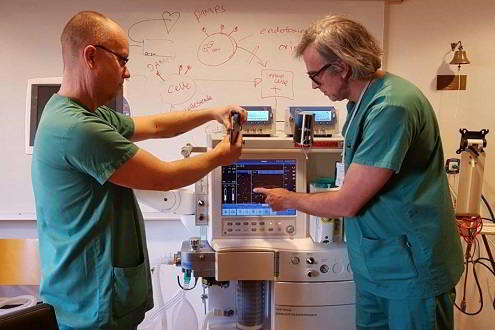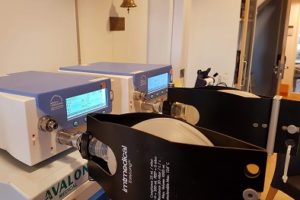
Views: 46
– Scientists are already preparing for the situation that may require multiple use of a veltilator.
Minapim by Hernan Valenzuela: A ventilator is a machine that breathes for the patient. It blows air mixed with extra oxygen into the lungs and releases it again in a controlled manner. For an intensive care patient, the respirator can save lives.
If each respirator could be used by more than one person, the capacity would increase significantly. A research group from the University of Oslo (UiO) and the University Hospital of Oslo (OUS) took the first steps to see if the method could work.
– There are many in the clinical setting around the world talking about this, but there is no documentation, says Håvard Kalvøy.
He is a Visiting Researcher in the UiO Physics Department and head of the OUS Medical Technology Research and Development Department.
Kalvøy says the method was used during the mass shooting in Las Vegas in 2017, but it has not been documented how it worked.
There is a lot that needs to be checked before this is recommended for use in hospitals.
Connects to a T tube
The principle itself is quite simple. (See the video further down in the article.)
– You connect a T-tube and divide the air in two. The airflow can also be divided again, resulting in four patients per ventilator, explains Kalvøy.
– Nobody would recommend it as usual, but in a crisis situation it can save two or four instead of just one.
It is also important to find out if the method has anything hidden.
– If it turns out it doesn’t work, it is better to save one than all four in the ventilator array, said Kalvøy.
They have already completed the first tests. Not in humans and real lungs, but in artificial lungs.
Must be adapted to different lungs
Our lungs are not the same. So it can go wrong if two patients receive air at the same speed and strength.
– One patient may have stiff lungs, while others may have more docile lungs. They have different forms of adaptation. There are also big differences in the lungs of children and adults, says Kalvøy.

– When you’re sick, each patient’s lungs can also change a lot along the way.
This means that the same air flow may be too much for one patient and too small for another. In the lab, researchers have the opportunity to adjust these settings in the test lungs to see how they respond.
Step by step
The first simple tests that the researchers have already carried out confirmed what the researchers thought about how the lungs should behave with varying resistance and sensitivity. Here they used equipment that they already had available.
Now they are carrying out other experiments in which they adjust the sensitivity and resistance in the lungs. And they have valves and sensors that can be used to adjust the airflow and resistance of the various tubes.
“The last round of testing also showed counterintuitive results,” says Kalvøy.
In standard configurations, the most susceptible lung was better ventilated. It is thought that the most docile is the healthiest, so that was not surprising.
– But in special environments relevant to covid-19, in fact, the most susceptible lung, that is, the healthiest lung, was less ventilated than the most rigid.

It is the opposite of what many may have thought in advance and it is something that researchers will look for more in the next experiments.
– We are also developing electronics in which a PC can control each patient’s air more individually, says Kalvøy.
I do not recommend
Kalvøy emphasizes that they will not make recommendations to doctors who work in the clinics.
– What we do is create a technical report where we scientifically document how this works in the different lungs. We do not answer if the method is suitable. Our goal is to provide an answer to all technical questions, he says.
In this video, Belgian researchers show how a ventilator divides:
According to Kalvøy, there are different opinions among doctors about the usefulness of the method. Some are enthusiastic, others more skeptical.
– If we can provide scientific documentation, it will be easier for doctors to agree on good decisions, says Kalvøy.
Source: Oslo University
Related article: Medical – Automating artificial intelligence for decision-making